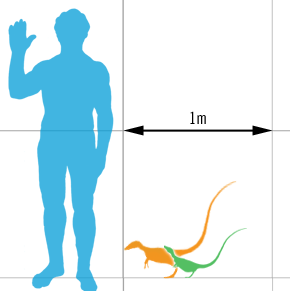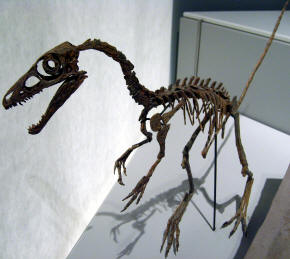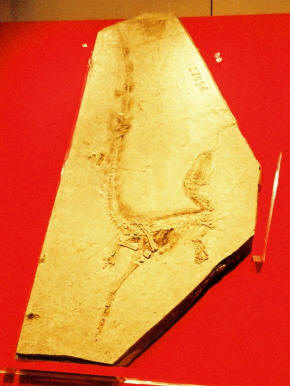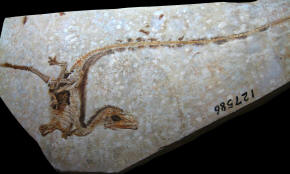|
Description
 |
| Size of adult and sub-adult specimens, compared with a human
(Picture
Source) |
Sinosauropteryx prima
is among the smallest known non-avian theropods, with the type specimen (a
nearly mature individual) measuring only 68 cm (27 in) in length, including
a very long tail. The largest known specimens
reach up to 98 cm (39 in) in length.
Sinosauropteryx is distinguished from other
small dinosaurs by several features, including having a skull longer than
its upper leg bone (femur) and very short, stout forelimbs, with the arms
being only 30% the length of the legs. Overall,
Sinosauropteryx had
proportionately shorter limbs than its close relative
Compsognathus.
In addition,
Sinosauropteryx had
several features unique among all other theropods (bipedal,
mainly carnivorous dinosaurs).
S. prima
had 64 vertebrae in its tail, giving it the longest tail relative to body
length of any theropod. It also had very large fingers for its small arms,
with the second finger and claw being longer than the entire lower arm
(radius).
Three specimens have been assigned
to Sinosauropteryx prima:
the
holotype GMV 2123 (NIGP
127586), and two referred specimens: NIGP 127587 and D 2141. The assignment
of a fourth, larger specimen to S. prima
was later found to be in error. All of the
fossils were found in the Jianshangou and Dawangzhangzi Beds of the
Yixian Formation in the
Beipiao and Lingyuan regions of
Liaoning, China. These
fossil beds have been dated to 124.6-122 million years ago, during the late
Barremian to early
Aptian stages of the
Early Cretaceous.
Classification
 |
| Cast of the skeleton belonging to GMV 2124, formerly classified as
Sinosauropteryx (Picture
Source) |
There is only one named species of
Sinosauropteryx,
S. prima. A
possible second species is represented by the specimen
GMV 2124 (aka NGMC
2124), which was described as another, larger specimen of
S. prima by Ji and Ji in
1997. However, in a 2002 presentation for the
Society of Vertebrate Paleontology, Nick Longrich showed that this specimen
differs in several anatomical aspects from the others, including its
relatively large size, proportionally longer tibiae, and shorter
tail. Longrich suggested that the GMV 2124 specimen was a compsognathid
coelurosaur, while
Sinosauropteryx
proper was a more primitive kind of coeurosaur or even a primitive carnosaur. In 2007,
Gishlick and Gauthier also concluded that this specimen was probably a new
taxon, and tentatively re-classified it as
Sinosauropteryx? sp., though they suggested it
may belong in a new genus. In the same year, Ji,
Ji and colleagues changed their opinion and also suggested GMV 2124 is
probably a new genus.
Sinosauropteryx
is important because it had feather-like structures, yet was not very
closely related to the previous "first bird"
Archaeopteryx. There
are many dinosaur families that were more closely related to
Archaeopteryx than
Sinosauropteryx was,
including the
deinonychosaurians, the
oviraptorosaurians, and
the
therizinosauroids. This
indicates that feathers may have been a characteristic of many theropod dinosaurs, not
just the obviously bird-like ones, making it possible that equally distant
animals such as
Ornitholestes,
Coelurus, and
Compsognathus had
feathers as well, although their close proximity to the origin of feathers
and the presence of scales on
Juravenator and
Tyrannosaurus make the
distribution of feathers in primitive coelurosaurs extremely difficult to
estimate accurately.
Most paleontologists do not consider
Sinosauropteryx to
be a bird, because
phylogenetically, it
lies far from the
clade Aves, usually
defined as Archaeopteryx
plus modern birds. The scientists who discovered and described
Sinosauropteryx, however,
used a character-based, or
apomorphic, definition
of the
Class Aves, that is, a
definition in which any animal with feathers is considered to be a bird.
They argued that the filamentous plumes of
Sinosauropteryx represent true feathers with a
rachis and barbs, and
thus that Sinosauropteryx
should be considered a true bird. They
classified it as belonging to a new biological
order,
Sinosauropterygiformes,
family Sinosauropterygidae,
within the subclass
Sauriurae.
Paleobiology
Diet
The specimen NIGP 127587 was
preserved with the remains of a lizard (complete with
skull) in its stomach, indicating that small, fast-moving animals made up
part of the diet of
Sinosauropteryx prima.
Numerous lizards of this type had previously been found in the same rocks as
Sinosauropteryx but
have yet to be described.
Another possible
Sinosauropteryx specimen,
GMV 2124 (Sinosauropteryx? sp.),
was found with three mammal jaws in its stomach region. Hurum, Luo &
Kielan-Jaworowska identified two of these jaws as belonging to
Zhangheotherium and
the third to
Sinobaatar, showing
that these two mammals were part of the animal's diet. Interestingly,
Zhangheotherium is known
to have had a
venom-secreting spur,
like the modern
platypus, showing that
Sinosauropteryx fed
on possibly venomous mammals.
Fossil Eggs
In the same specimen of
S. prima that preserved
the complete stomach contents including a lizard (NIGP 127587), several
small eggs were also
discovered in the abdomen. Two eggs were preserved just in front of and
above the pubic boot, and several more may lie underneath them on the slab.
It is unlikely that these were eaten by the animal, as they were in the
wrong part of the body cavity for the egg shells to have remained intact. It
is more likely that these are unlaid eggs produced by the animal itself.
Each egg measured 36 millimeters (1.4 inch) long by 26 mm
(1 in) wide. The total length of this individual was 1.07 m (3.5 ft).
Feathers
All descrbed specimens of
Sinosauropteryx preserve
integumentary structures
(filaments
 |
| Image showing the entire holotype specimen, on exhibit in Japan
|
arising from the skin) which most paleontologists interpret as
very primitive feathers. These short,
down-like filaments are preserved all along the back half of the skull,
arms, neck, back, and top and bottom of the tail. Additional patches of
feathers have been identified on the sides of the body, and paleontologist
Chen, Dong and Zheng proposed that the density of the feathers on the back
and the randomness of the patches elsewhere on the body indicated the
animals would have been fully feathered in life, with the ventral feathers
having been removed by decomposition.
The filaments are preserved with a
gap between the bones, which several authors have noted corresponds closely
to the expected amount of skin and muscle tissue that would have been
present in life. The feathers adhere close to the bone on the skull and end
of the tail, where little to no muscle was present, and the gap increases
over the back vertebrae, where more musculature would be expected,
indicating that the filaments were external to the skin and do not
correspond with sub-cutaneous structures.
The random positioning of the
filaments and often "wavy" lines of preservation indicate that they were
soft and pliable in life. Examination with microscopes shows that each
individual filament appears dark along the edges and light internally,
suggesting that they were hollow, like modern feathers. Compared to modern
mammals the filaments
were quite coarse, with each individual strand much larger and thicker than
the corresponding hairs of similarly
sized mammals.
The length of the filaments varied
across the body. They were shortest just in front of the eyes, with a length
of 13 mm. Going further down the body, the filaments rapidly increase in
length until reaching 35 mm long over the shoulder blades. The length
remains uniform over the back, until beyond the hips, when the filaments
lengthen again and reach their maximum length midway down the tail at 40 mm.
The filaments on the underside of the tail are shorter overall and decrease
in length more rapidly than those on the dorsal surface. By the 25th tail
vertebrae, the filaments on the underside reach a length of only 35 mm. The
longest feathers present on the forearm measured 14 mm.
Though the feathers are too dense to
isolate a single structure for examination, several studies have suggested
that the presence of two distinct types of filament (thick and thin)
interspersed with each other, the tendency for the thick filaments to appear
'stiffer' than thin filaments, and the tendency of thin filaments to lie
parallel to each other but at angles to nearby thick filaments, suggests
that the individual feathers consisted of a central quill (rachis)
with thinner barbs
branching off from it, similar to but more primitive in structure than
modern bird feathers. Overall, the filaments
most closely resemble the "plumules" or down-like feathers of some modern
birds, with a thick central quill and long, thin barbs. The same structures
are seen in other fossils from the
Yixian Formation,
including
Confuciusornis.
Coloration
The fossils of
Sinosauropteryx have shown
an alternation of lighter and darker bands preserved on the tail, which may
give an indication of what the animal looked like in life. Chen and
colleagues initially interpreted this banding pattern as an artifact of the
splitting between the main slab and
counter-slab in which
the original specimen was preserved. However, in
a 2002 lecture and corresponding abstract for the
Society of Vertebrate Paleontology,
paleontologist Nick Longrich suggested that these specimens actually
preserve remnants of the original colouration pattern the animal would have
exhibited in life. He argued that the dark, banded stains on the tail were
too evenly spaced to have been caused by random separation of the fossil
slabs, and that they represent fossilized pigments present in the feathers.
Additionally, rather than an artifact of preservation or decomposition, the
presence of dark feathers along only the top of the body may also reflect
the colour pattern in life, indicating that
Sinosauropteryx prima was
countershaded with dark
colouration on its back and lighter colouration on its underside, with bands
or stripes on the tail for camouflage.
Longrich's conclusions were
supported in a paper first published online in the journal
Nature in January 2010.
Fucheng Zhang and colleagues examined the fossilized feathers of several
dinosaurs and early birds, and found evidence that they preserved
melanosomes, the cells
that give the feathers of modern birds their colour. By examining melanosome
structure and distribution, Zhang and colleagues were able to confirm the
presence of light and dark bands of colour in the tail of
Sinosauropteryx.
Furthermore, the team was able to compare melanosome types to those of
modern birds to determine a general range of colour. From the presence of
phaeomelanosomes, spherical melanosomes that make and store red pigment,
they concluded that the darker feathers of
Sinosauropteryx were chestnut or reddish brown
in colour.
History of Discovery
The first fossil specimen of the
dinosaur later named Sinosauropteryx prima
was uncovered in August 1996 by Li Yumin. Yumin was a farmer and part-time
fossil hunter who often prospected around Liaoning province in order to
acquire fossils to sell to individuals and museums. Yumin recognized the
unique quality of the specimen, which was separated into two slabs, and sold
the slabs to two separate museums in China: the National Geological Museum
in
Beijing, and the
Nanjing Institute of
Geology and Paleontology. The director of the Beijing museum, Ji Qiang,
recognized the importance of the find, as did visiting Canadian
paleontologist
Phil Currie and artist
Michael Skrepnick, who became aware of the fossil by chance as they explored
the Beijing museum's collections after leading a fossil tour of the area
during the first week of October, 1996. Currie recognized the significance
of the fossil immediately. As The New York
Times quoted him, "When I saw this slab of silt
stone mixed with volcanic ash in which the creature is embedded, I was
bowled over."
Chinese authorities initially barred
photographs of the specimen from publication. However, Currie brought a
photograph to the 1996 meeting of the
Society of Vertebrate Paleontology
at the
American Museum of Natural History
in New York, causing crowds of paleontologists to gather and discuss the new
discovery. The news reportedly left paleontologist
John Ostrom, who in the
1970s had pioneered the theory that birds evolved from dinosaurs, "in a
state of shock." Ostrom later joined an
international team of researchers who gathered in Beijing to examine the
fossils other team members included feather expert Alan Brush, fossil bird
expert
Larry Martin, and
Peter Wellnhofer, an
expert on the early bird
Archaeopteryx.
Controversy regarding the identity
of the filaments preserved in the
Sinosauropteryx specimen began almost
immediately, as the team of scientists spent three days in Beijing examining
the specimen under a microscope. The results of their studies (reported
during a press conference at the Philadelphia Academy of Natural Science on
Thursday, April 24, 1997) were inconclusive; the team agreed that the
structures preserved on Sinosauropteryx
were not modern feathers, but suggested further research was required to
discover their exact nature. Paleontologist
Alan Feduccia, who had
not yet examined the specimen, wrote in
Audubon Magazine that
the structures on Sinosauropteryx
(which he considered at the time to be a synonym of
Compsognathus, as
Compsognathus prima) were
stiffening structures from a frill running along the back, and that dinosaur
paleontologists were engaging in wishful thinking when equating the
structures with feathers. Subsequent
publications saw some of the same team members disagreeing over the identity
of the structures, though a majority of scientists have argued for their
relationship to feathers as opposed to internal or structural fibers of the
skin.
If you ordered the Test Pack, it is now time to
take Test 3.
Return to the
Old Earth Ministries Online Dinosaur
Curriculum homepage.

Shopping
|



